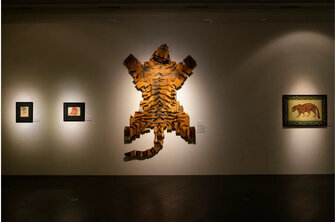Curator: Magrarita Godina
Art is no doubt a desirable habitat for many an animal species. Bulls and rhinos, tigers and elephants, beetles and deer, gorillas and flamingos have inhabited the realm of visual arts for centuries. From time immemorial, artists have depicted animals; the creators of prehistoric cave paintings gave rise to a new genre, which has since evolved undergoing numerous transformations in line with to the latest developments in global culture and politics, changing tastes, and the advent of new artistic techniques and inventions. From the caves of Lascaux and Altamira to Albrecht Dürer's The Rhinoceros to Damien Hirst's tiger shark preserved in formaldehyde and Maurizio Cattelan's taxidermic horse suspended from a ceiling – animals have long been a source of inspiration and metaphor in art. They have come a very long way from being worshipped as sacred objects to being depicted in paintings hanging on the walls of our homes and sentimental pictures adorned with gilded frames, to becoming design items and, eventually, a symbol of sustainable development and environmental activism. Not unlike insects that employ camouflage to resemble sticks or twigs or other, dangerous species, animals that "live" in museums adapt to our reality and become a universal language that can be used to describe all sorts of changes.
Animals and the way we treat them are still important topics of earnest contemplation. The latest discoveries made by biologists since the turn of the millennium have not only changed the way we see the world we live in but are also slowly but surely changing the way we look at animals. Once regarded as objects of worship, fear and study, they have become creatures we are trying to protect. Artists, just like zoologists, study animals, their habits and changing looks, while museums – ever since Salvador Dalà used live snails in his 1938 installation Rainy Taxi – have been pondering the ethical dilemma of whether it is justifiable to include living creatures in works of art, a practice that could be seen as the most radical attempt to label all things as potential found objects. Nowadays, cultural institutions, when faced with the choice between animal rights and an artist's right to express themselves freely, have been increasingly often siding with animals.
Living in unity with nature and the fear of the early stages of its possible destruction are some of the recurrent motifs in contemporary art. Artists share with us their vision of a world which nature seems to have been banished from or a world that is reverting to a wild state following global changes.
It is not for the first time that the Ekaterina Cultural Foundation has addressed the issue of animal protection and welfare; the Foundation's collection boasts many pieces concerned with flora and fauna, which make up an entire population that migrates between various exhibitions (including "Movement. Evolution. Art" and "On Sharks & Humanity") displaying new traits every time we see them.
The exhibition Art Fauna is a metaphorical menagerie where animals are divided into species while the rooms hosting the exhibition serve as a natural habitat that is just as diverse as the habitats real animals live in. Deer that we previously saw in Niko Pirosmani's pictures now inhabit Viktor Alimpiev's videos; Rostan Tavasiev has invented the art of "hippo-painting" with animals in his works breaking the conventions of two-dimensional images; Dmitry Tsykalov makes "hunting trophies" out of ammo crates; while new hybrid species are being born in paintings by Olga Tobreluts.
The exhibition looks to reinvent the role of animals in art and include them in the biodiversity support and conservation programme. The Moscow Zoo, a partner of the exhibition, encourages its visitors to become patrons of the zoo and contribute to the effort of conserving biodiversity on planet Earth. Creating new populations of rare and endangered species is one of the zoo's top priorities. And joining the zoo's patronage programme is a unique opportunity to take part in a bid to save the variability among living organisms on the earth.






